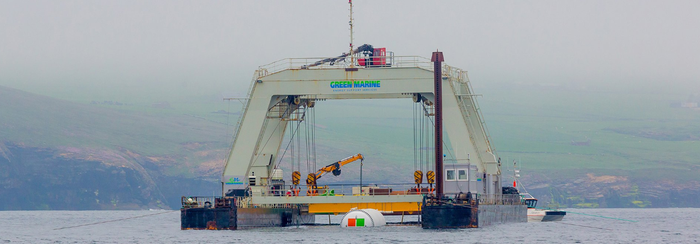Microsoft sinks casually drops data centre into the North Sea
Microsoft’s Project Natick is entering into its second phase of development, and actually sinking a data centre 117 feet into the North Sea, a couple of miles off the coast of Scotland’s Orkney Islands.
June 7, 2018

Microsoft’s Project Natick is entering into its second phase of development, and actually sinking a data centre 117 feet into the North Sea, a couple of miles off the coast of Scotland’s Orkney Islands.
It certainly is a novel idea, and while it does sound like a bit of a PR gambit, there is some sound logic. Its small enough to manufacture and deploy pretty quickly, low temperatures at the seabed reduce cooling bills, around half the world’s population live within 120 miles of the coast and when connected to renewable energy sources on the surface, it becomes notably cheaper to run.
The data centre itself has been designed by Naval Group, a French business with expertise in engineering, manufacturing and maintaining military-grade ships and submarines, is contained-sized, loaded with 12 racks containing a total of 864 servers and associated cooling system infrastructure. The systems have been designed as simply as possible to remove the need for human intervention, as when the data centre has been lowered to the seafloor, it is impossible for humans to gain entry.
This is another aspect of Project Natick which is both exciting and worrying for the data centre workforce; the asset is designed to be a ‘Light Out’ operation, essentially meaning automation plays a big role here, though remote control and maintenance is possible. If something breaks, it breaks, but the PoC vessel operated in the same Lights Out manner for 105 days. This is a good start, but for the idea to be commercially viable, Microsoft will have to prove the data centre can remain operational for five years.
“The most joyful moment of the day was when the data centre finally slipped beneath the surface on its slow, carefully scripted journey,” said Project Leader Ben Cutler.

The idea is a good one, but now the team has to prove the theory is one which will be economically, environmentally and operationally sound. First and foremost is the sturdiness of the data centre. The test site, the European Marine Energy Centre, is one of the rougher locations in the North Sea, with tidal currents travelling up to nine miles per hour at peak intensity and the sea surface regularly roils with 10-foot waves that whip up to more than 60 feet in stormy conditions.
“We know if we can put something in here and it survives, we are good for just about any place we want to go,” said Cutler.
Another test will be making sure the theory of energy self-sufficient data centres is a sound one. Colocation with marine renewable energy is an important step here, and could allow Microsoft to bring services to regions of the world with unreliable electricity, and eliminate the need for costly backup generators in case of power grid failures. In this test, a cable from the Orkney Island grid sends electricity to the data centre, which requires just under a quarter of a megawatt of power when operating at full capacity. The Orkney Islands are actually 100% powered by renewable energy, a mix of solar, wind and marine.

The cooling system is another way in which Microsoft can potentially make the data centre more sustainable and efficient to run, as the water surrounding the submerged asset will be pumped through the system to cool the servers. Add in the consistently low temperature of the water at the seabed and the cooling problem of data centres becomes a lot more feasible.
Aside from proving it can be powered and operated, the team also have to demonstrate the logistical side. Building the data centre in the shape of a container means there are a variety of sizes available and it can be easily transported from the factory. This is a positive, as is the successful deployment, using 10 winches, a crane and a gantry barge, as well as a remotely operated vehicle that accompanied the data centre on its journey, but at the end of the experiment, the team need to get the asset back out. Recycling the asset is key for the business model here, and despite it being powered by renewable energy, we suspect Microsoft would have few green fans if it just left it at the bottom of the ocean.
The promise of the project is very attractive. With the rapid growth of internet usage and the increasing data-intensity of applications, infrastructure needs to scale quickly. The idea offers speedy and flexible deployment, low latency, environmentally friendly and cost-effective, but there are still a lot of unknowns. Whether Microsoft can operate a data centre with zero human intervention for five years, in a harsh environment, remains to be seen, but it could be onto a winner.
About the Author
You May Also Like


.png?width=300&auto=webp&quality=80&disable=upscale)







.png?width=300&auto=webp&quality=80&disable=upscale)


_1.jpg?width=300&auto=webp&quality=80&disable=upscale)